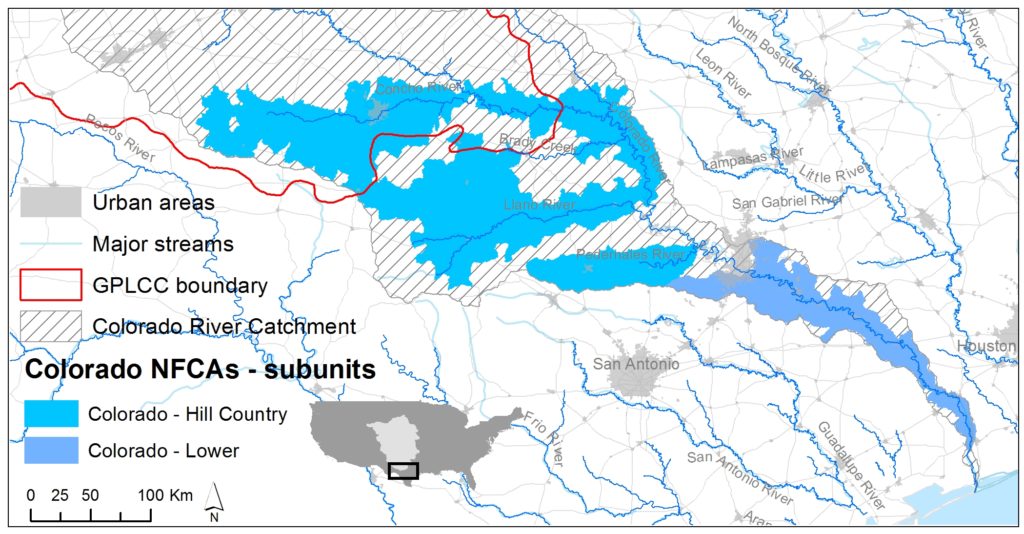CENTRAL EDWARDS PLATEAU RIVERS and SOUTHERN EDWARDS PLATEAU RIVERS NFCAs
Conservation Profile
Ecoregion
Edwards Plateau.
Biotic Province
Balconian
Stresses
“The primary threat is groundwater extraction and the resultant reduction or loss of spring flows. This is also one of the fastest developing regions in the United States. The complexities at the interface of conservation and human population growth makes resource management even more challenging than usual.”
Partners
The Nature Conservancy, TPWD, USFWS, LCRA, Hill Country Alliance, Colorado River Municipal Water District, Llano River Watershed Alliance, Concho Conservancy Associations
Fish species of concern
Atractosteus spatula (Alligator Gar)
Anguilla rostrata (American Eel)
Cyprinella lepida (Plateau Shiner)
Cyprinella sp. (Nueces River Shiner)
Dionda flavipinnis (Guadalupe Roundnose Minnow)
Dionda nigrotaeniata (Medina Roundnose Minnow)
Dionda serena (Frio Roundnose Minnow)
Dionda sp. 3 (Colorado Roundnose Minnow)
Dionda texensis (Nueces Roundnose Minnow)
Hybognathus placitus (Plains Minnow)
Macrhybopsis hyostoma (Shoal chub)
Macrhybopsis marconis (Burrhead Chub)
Notropis buccula (Smalleye Shiner)
Notropis oxyrhynchus (Sharpnose Shiner)
Phenacobius mirabilis (Suckermouth Minnow)
Carpiodes sp. (Llano River Carpsucker)
Cycleptus elongatus (Blue Sucker)
Minytrema melanops (Spotted Sucker)
Ictalurus lupus (Headwater Catfish)
Satan eurystomus (Widemouth Blindcat)
Trogloglanis pattersoni (Toothless Blindcat)
Gambusia heterochir (Clear Creek Gambusia)
Micropterus salmoides nuecensis (Rio Grande Largemouth Bass)
Micropterus treculii (Guadalupe Bass)
Muscles of Concern (Federal Candidates)
Lampsilis bracteata (Texas Fatmucket)
Quadrula aurea (Golden Orb)
Quadrula houstonensis (Smooth Pimpleback)
Quadrula petrina (Texas Pimpleback)
Truncilla macrodon (Texas Fawnsfoot)
Muscles of Concern (Under federal review)
Quincuncina mitchelli (False Spike)
 The Colorado River Hill Country NFCA includes the Concho, Llano, and Pedernales rivers and encompasses the biologically diverse Edwards Plateau Region of Central Texas, the southernmost unit of the Great Plains (TSHA). The Edwards Plateau is an erosional region with thin soils overlying limestones. “The western portion remains a relatively flat elevated plateau whereas the eastern portion known as the Hill Country is deeply eroded” (TPWD).
The Colorado River Hill Country NFCA includes the Concho, Llano, and Pedernales rivers and encompasses the biologically diverse Edwards Plateau Region of Central Texas, the southernmost unit of the Great Plains (TSHA). The Edwards Plateau is an erosional region with thin soils overlying limestones. “The western portion remains a relatively flat elevated plateau whereas the eastern portion known as the Hill Country is deeply eroded” (TPWD).
Historically, the landscape hosted a variety of habitats, from grasslands, shrublands, oak-mesquite savannahs, and riparian corridors to the more dominant woodlands and forests (NC Conservation Assessment). The natural disturbances of fire and grazing by bison and antelope maintained this diversity (TPWD). The region lacks deep soils necessary for farming; however, settlers found it suitable for grazing cattle, sheep, and goats (TSHA). Overgrazing by domestic livestock and overabundant white-tailed deer combined with fire suppression and drought led to encroachment in some areas by juniper, colloquially known as cedar; however, misinformation regarding juniper has led to ecologically unsound land management practices (Hill Country Land and Trust). Texas hosts half of the feral hogs found in the U.S., one of its most destructive invasive species (Smithsonian Mag). Hog behavior is particularly harmful in riparian areas as their rooting activities destabilize river banks and muck up smaller streams and wetlands (TPWD-pigs). This portion of the Colorado River suffers the effects of many impoundments, the most prominent being the series of dams that form the Highland Lakes. These huge reservoirs, managed by the Lower Colorado River Authority, effect the Colorado River all the way to its mouth at the Gulf of Mexico (LCRA).
Erosion and solution of limestone by the many springs, streams, and rivers has carved rugged canyons above ground and karst features below, many large enough to be called caves. Some of these karst features, the Edwards and Trinity aquifers, are an important source of freshwater; however, their natural discharg, the clear, cool, perennial seeps and streams characteristic of the region, contributes flow to the rivers and supports a diverse assemblage of rare species, including a yet to be described salamander (Pedernales CAP). The more cave-obligate species exhibit interesting adaptations such as a lack of pigmentation or reduced eyes. Some may venture above ground, but are still highly adapted to the unique spring environment. Many of these species are highly endemic, occupying a handful, or sometimes, just one karst feature of the Edwards Plateau (NC Conservation Assessment). The unique karst environments that these species occupy highlights the most prominent threat: groundwater extraction. The Hill Country is one of the fastest developing regions in the United States. Poorly planned population growth threatens to further fragment and strain the water resources of this region.
Sources:
Nature Conservancy Conservation Assessment:
Southern Edwards Plateau HCP: http://www.sephcp.com/documents.html
TSHA (TX State Historical Assoc): https://tshaonline.org/handbook/online/articles/rxe01
TPWD: http://tpwd.texas.gov/landwater/land/habitats/cross_timbers/ecoregions/edwards_plateau.phtml
Pedernales CAP (Conservation Plan for the Pederanales you sent me)
TPWD-pigs: http://tpwd.texas.gov/huntwild/wild/nuisance/feral_hogs/
Hill Country Land and Trust: http://www.hillcountrylandtrust.org/pdf_files/FAQ-Managing-Ashe-Juniper_v2.pdf
Smithsonian Mag: http://www.smithsonianmag.com/science-nature/a-plague-of-pigs-in-texas-73769069/?no-ist
